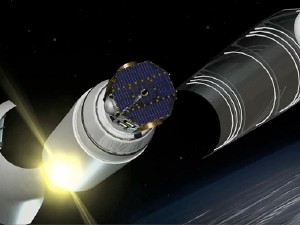Oct 18 2008
A new NASA mission, IBEX, launches this weekend, geared to probe the very edge of the solar system from a high Earth orbit. One of its two instruments is a compact Los Alamos device called the High Energy Neutral Atom Imager.
 Artist's impression of IBEX's launch and deployment. Credit: NASA/GSFC.
Artist's impression of IBEX's launch and deployment. Credit: NASA/GSFC.
The mission, called the Interstellar Boundary Explorer (IBEX) satellite, is scheduled to launch on Sunday, Oct. 19, at 1:48 p.m. EDT, during a launch window that extends from 1:44 p.m. to 1:52 p.m. The two-year mission will begin from the U.S. Army’s Reagan Test Site at Kwajalein Atoll, a part of the Marshall Islands in the south Pacific Ocean and carry two Energetic Neutral Atom cameras into orbit around Earth where they will detect atoms that are emitted from a region where the outermost reaches of our solar system meets the vast interstellar space.
Our solar system lies in a protective bubble created by material and magnetic fields that flow out of the sun. As the solar wind streams out far beyond Pluto, racing a million miles per hour, it reaches the edge of our bubble and collides with an enormous interstellar cloud through which we are moving. A shock wave forms where they meet. The Los Alamos instrument, built in collaboration with Southwest Research Institute, the University of New Hampshire, and the University of Montana, detects the atoms that are heated and thrown off from that boundary.
“These atoms represent the sound of the shock, and they are barely audible. We will only measure a few thousand atoms each day, so we had to make a jumbo camera. Only our camera detects atoms instead of light,” said Herb Funsten, Los Alamos’s principal investigator on the instrument.
“Every six months we will make global sky maps of where these atoms come from and how fast they are traveling. From this information, we will be able to discover what the edge of our bubble looks like and learn about the properties of the interstellar cloud that lies beyond the bubble,” he said.
The craft itself will be launched on an Orbital Sciences Pegasus XL rocket that is dropped from an Orbital Sciences L-1011 aircraft over the Pacific Ocean about 125 miles north of Kwajalein, and the rocket will carry the satellite out to a high-altitude orbit that reaches 150,000 miles above the Earth.
Said Funsten, “This will be our first panoramic view of this gateway into our galaxy. We are in for some incredible discoveries.”
Southwest Research Institute (SwRI) in San Antonio leads the IBEX mission. In addition to its boundary-zone studies, the mission also will study galactic cosmic rays, energetic particles from beyond the Solar System that pose a health and safety hazard for humans exploring beyond Earth orbit. IBEX will explore how the solar wind regulates this cosmic ray radiation.
For IBEX, SwRI is partnering with Orbital Science Corporation, Los Alamos National Laboratory, Lockheed Martin Advanced Technology Center, NASA Goddard Space Flight Center, the University of New Hampshire, the Applied Physics Laboratory, the University of Southern California, and the University of Montana. The team also includes a number of U.S. and other scientists from universities and other institutions, as well as Chicago’s Adler Planetarium, which is leading education and public outreach for the mission. Live coverage of the IBEX launch will be provided via the Web. No live NASA Television coverage is planned. The live streaming video of the countdown and launch will be available on the NASA home page at http://www.nasa.gov .
For information of these missions on the Internet, see http://www.nasa.gov/ibex and http://www.ibex.swri.edu/ .